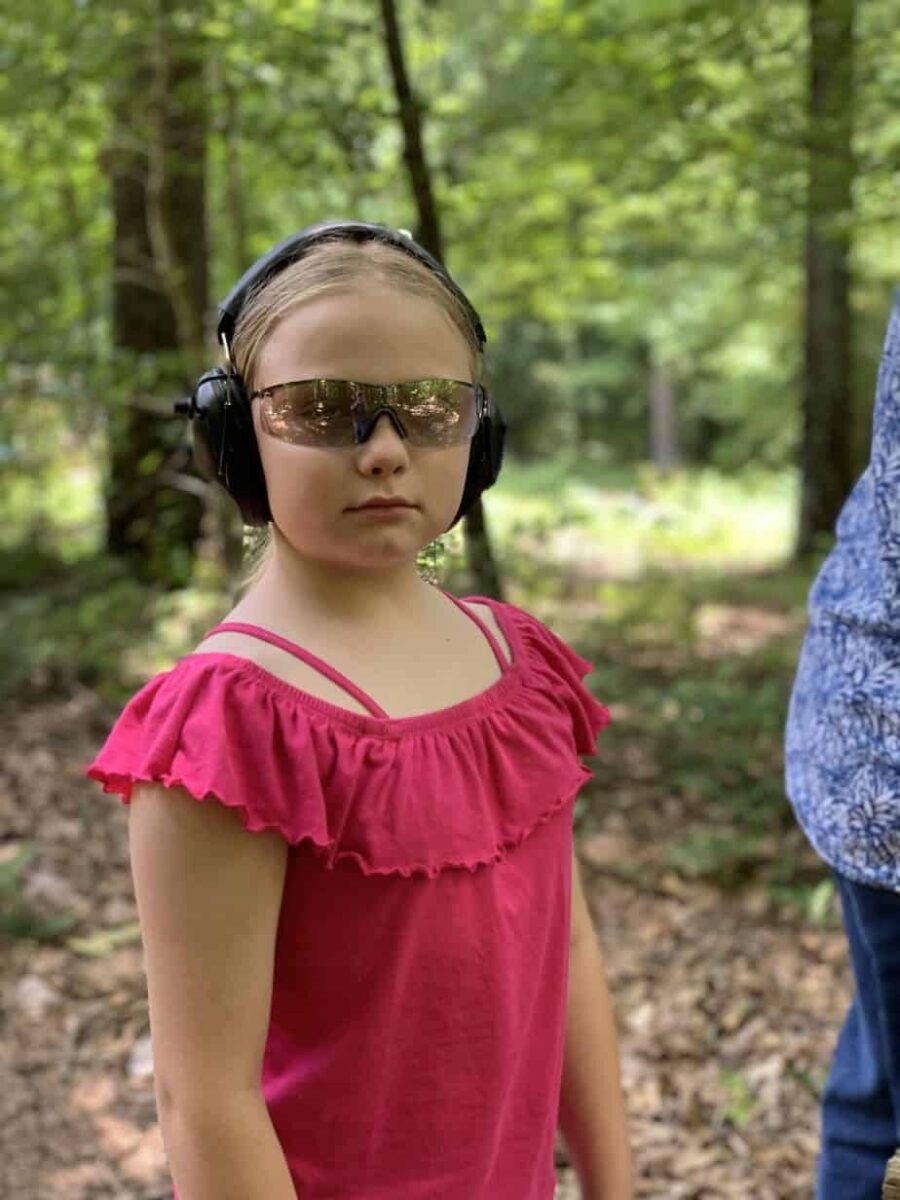If you have been reading my blog regularly, you know that eye and ear protection are not optional for shooting practice. Let’s take a look at the specifics about why you need protection, when you need protection, and how to get the right protection.
Why You Need Ear Protection When You Shoot
As a speech-language pathologist, I see patients with hearing loss on a regular basis. The causes of hearing loss range from the unpreventable, like congenital hearing loss, to the avoidable losses that result from noise exposure. There is actually a name for it: Noise Induced Hearing Loss.
How Your Ear Works
Your ear is divided into the outer ear, the middle ear, and the inner ear. The outer ear is the part you see. Its rounded shape forms a funnel to conduct the sound into your ear canal.
The middle ear includes the eardrum and the three bones called ossicles. You may remember them from grade school as the hammer, anvil, and stirrup, but anatomists refer to them as the malleus, incus, and stapes.
The ear drum, also known as the tympanic membrane, moves in response to the vibration of sound. Amazingly, this small membrane captures the nuances of pitch, loudness, and sound quality with these minute movements.
The ossicles respond to the eardrum’s movement with their own movement, sending a signal to the inner ear.
The inner ear includes the cochlea and the semicircular canals. The fluid-filled cochlea is shaped like a snail and has little hair cells to further transmit the motions of the ossicles.
The hair cells activate selectively depending on the sound being detected. They transmit electrical signals to the auditory nerve. Your brain interprets these signals as sound.
The semicircular canals help you maintain balance.
What Can Go Wrong With Hearing
Hearing loss interferes with understanding speech. You may be unable to localize the source of a sound. It can cause annoying buzzing or ringing sounds in your ear. It can even cause pain and loss of balance.
Hearing loss can be conductive, sensorineural, or mixed. Mixed hearing loss is simply a combination of conductive and sensorineural losses.
Conductive Hearing Loss
Conductive hearing loss occurs when something is physically obstructing the movement of the eardrum.
This could be fluid in the middle ear, earwax, a poorly functioning Eustachian tube, an infection, the way your ear was formed, a growth, or something that got stuck in there, like a bug.
Sensorineural Hearing Loss
Sensorineural hearing loss occurs with damage to the inner ear. This tends not to be fixable with drugs or surgery. You may need a hearing aid if you damage your inner ear.
Sensorineural loss can be caused by illness, certain drugs that are ototoxic (ear damaging), inherited problems, aging, a blow to the head, a problem with the way your ear is formed, or exposure to loud noises.
Unprotected exposure to the sounds of shooting can set you up for sensorineural hearing loss. A loud enough boom could cause hearing loss with only one exposure. Multiple exposures to smaller noises can cause more gradual loss.
How Loud is Too Loud?
I went to the website of the American Speech-Hearing-Language Association (ASHA) to see their official stance on hearing protection for firearms use. The loss of hearing starts around 140 decibels (dB), which is the loudness of a small .22 caliber rifle.
Big bore rifles can exceed 175 dB, and accessories such as muzzle brakes can increase the noise level. The first unprotected shot can be the one that causes hearing loss.
The noise is amplified in a small space, increasing the risk. The risk is greater in the ear that is closer to the gun, particularly with long guns that nestle up near the ear.
The type of hearing loss you are likely to sustain is the loss of high-pitched sounds such as “s,” the same ones that are hard to hear when you are talking on the telephone.
What is a decibel?
The intensity (loudness) of sound is measured in decibels. The amplitude, or forcefulness of a sound, determines its decibel rating. A sound that is just barely audible is 0 decibels. Multiply that sound by 10 and you have a 10 decibel sound. Conversation is around 60 decibels.
Decibels are measured on a logarithmic scale, with each increase of 10 indicating a tenfold increase in pressure.
A 20 decibel sound is not 20 times the loudness of 0; it is multiplied by 100. A 30 decibel sound is 1000 times the loudness of 0 decibels. By the time you get to a 140 decibel gunshot, that is really loud.
Options to Prevent Hearing Loss
You don’t have to spend a lot of money on ear protection. Get foam ear plugs. These occlude your ear canal to reduce the sound coming in. You won’t be able to have a conversation with these in your ears.
If you want to go a step higher, you can get the earmuffs that block sound. They reduce the sound by 25 dB.
You can go up another step and get electronic earmuffs. These block the sound, but they also amplify the sound between shots so you can talk to your shooting partners.
Electronic ear muffs decrease the sound by 25 dB. Their volume is adjustable. Our daughter really likes hers.
I don’t like earmuffs because I can’t wear earrings with them. The ear coverings poke the earring posts into my head. (Our daughter says she wears flat back earrings, which have a flat post end that won’t poke into her head.) I opted for an electronic version of ear buds.
You insert the foam part into your ear for occlusion and hang the rest of it around your neck. It amplifies sound between shots but detects loud noises and dampens them.
My husband chose digital ear buds with Bluetooth. Normally over $200, they can be found on sale for less. These are contained completely in the outer ear, without wires. Be aware that electronics have a shorter life than other types of ear protection because of all the delicate wiring involved.
If you buy an electronic product that fits into your ear, you may want to look at different sizes of ear tips. Expect to be in the $10 range for a set.
Why Do I Need to Protect My Eyes When I Shoot?
Your eyesight is a precious gift that can be lost in a moment. As Grandma used to say, “It’s all fun and games until someone puts out an eye.”
How Your Eyes Work
Light reaches your eye through the cornea, the clear front layer of the eyeball. The cornea is dome shaped and bends to focus the light. The opening in the center of the eye is called the pupil.
The colored part around the pupil is the iris, which adjusts to let in more or less light. The clear inner part of the eye is the lens. It works with the cornea to focus the light.
The retina is a layer of tissue at the back of the eye. At this point the light becomes an electrical signal for the brain to interpret.
What Could Hurt My Eyes While Shooting?
All of these exquisitely sensitive parts are needed to help you see clearly, and you don’t want a stray casing or a piece of shrapnel to hit you in the eye while you shoot.
Revolvers retain their cases when they shoot, but rifles and semi-automatics eject a case each time a round is shot. That means a small piece of hot metal could bounce up into your eye from your gun or the gun next to you.
This is why you will hear the command to put on your “eyes and ears” when you are at a shooting range. Don’t enter the shooting area without your eye and ear protection. Don’t take it off until you are out of the shooting area.
Shooting glasses are a minimal expense if you just want something basic. Colored lenses are popular because they can help you pick up the target more easily.
Once you reach a more mature age, you may find yourself wanting special bifocals for shooting. Happily, they do exist. Price varies by magnification.
One more thing to protect while shooting is your financial situation. Get liability insurance.
Watch our YouTube channel for more helpful information on shooting safely.
To go into more depth on hearing, see this link to ASHA’s website.
To learn more about your eyes, go to the NIH website.
To learn more about decibels, go to healthyhearing.com



1 thought on “The Importance of Eye and Ear Protection When Shooting”
Comments are closed.